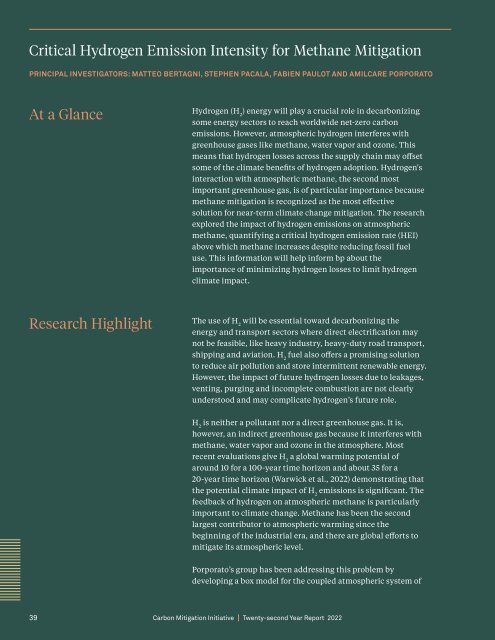CMI Annual Report 2022
Create successful ePaper yourself
Turn your PDF publications into a flip-book with our unique Google optimized e-Paper software.
Critical Hydrogen Emission Intensity for Methane Mitigation<br />
PRINCIPAL INVESTIGATORS: MATTEO BERTAGNI, STEPHEN PACALA, FABIEN PAULOT AND AMILCARE PORPORATO<br />
At a Glance<br />
Hydrogen (H 2<br />
) energy will play a crucial role in decarbonizing<br />
some energy sectors to reach worldwide net-zero carbon<br />
emissions. However, atmospheric hydrogen interferes with<br />
greenhouse gases like methane, water vapor and ozone. This<br />
means that hydrogen losses across the supply chain may offset<br />
some of the climate benefits of hydrogen adoption. Hydrogen's<br />
interaction with atmospheric methane, the second most<br />
important greenhouse gas, is of particular importance because<br />
methane mitigation is recognized as the most effective<br />
solution for near-term climate change mitigation. The research<br />
explored the impact of hydrogen emissions on atmospheric<br />
methane, quantifying a critical hydrogen emission rate (HEI)<br />
above which methane increases despite reducing fossil fuel<br />
use. This information will help inform bp about the<br />
importance of minimizing hydrogen losses to limit hydrogen<br />
climate impact.<br />
Research Highlight<br />
The use of H 2<br />
will be essential toward decarbonizing the<br />
energy and transport sectors where direct electrification may<br />
not be feasible, like heavy industry, heavy-duty road transport,<br />
shipping and aviation. H 2<br />
fuel also offers a promising solution<br />
to reduce air pollution and store intermittent renewable energy.<br />
However, the impact of future hydrogen losses due to leakages,<br />
venting, purging and incomplete combustion are not clearly<br />
understood and may complicate hydrogen’s future role.<br />
H 2<br />
is neither a pollutant nor a direct greenhouse gas. It is,<br />
however, an indirect greenhouse gas because it interferes with<br />
methane, water vapor and ozone in the atmosphere. Most<br />
recent evaluations give H 2<br />
a global warming potential of<br />
around 10 for a 100-year time horizon and about 35 for a<br />
20-year time horizon (Warwick et al., <strong>2022</strong>) demonstrating that<br />
the potential climate impact of H 2<br />
emissions is significant. The<br />
feedback of hydrogen on atmospheric methane is particularly<br />
important to climate change. Methane has been the second<br />
largest contributor to atmospheric warming since the<br />
beginning of the industrial era, and there are global efforts to<br />
mitigate its atmospheric level.<br />
Porporato’s group has been addressing this problem by<br />
developing a box model for the coupled atmospheric system of<br />
39<br />
Carbon Mitigation Initiative Twenty-second Year <strong>Report</strong> <strong>2022</strong>
















